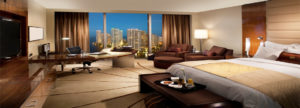 Pests can run, crawl, fly and hitch-hike their way into your hotel. Some paths are obvious like a door which is left open or poorly sealed, and some not so obvious.
Pests can run, crawl, fly and hitch-hike their way into your hotel. Some paths are obvious like a door which is left open or poorly sealed, and some not so obvious.
Here is a list of the ways pests can enter hotels and the methods for preventing entry.
Dumpster Compactors
Not only can dumpster compactor chutes provide entry points through poorly sealed chute designs, but the dumpsters themselves can attract and serve as breeding sites for pests. In fact, the dumpster box can be transporting pests to and from the waste disposal site depending on how the box is handled. If the garbage is merely emptied and not cleaned, fly maggots and other insects can continue to thrive inside the box. If the old dumpster is dropped at the waste disposal site and a new box delivered, it can bring pests with the recycled dumpster. This is one of the reasons that monitoring this area is so important to make sure that rodents or insect pests are not being transported to the site. Facilities should have a program in place for cleaning dumpsters, and dumpster pads, especially during the warm weather months. If there are interior doors to the compactor chute, they should remain closed at all times when the chute is not in use.
Guests
Unfortunately, pests can be brought into a facility with guests and their luggage. This is a major method of introduction for bed bugs. Training hotel staff to be alert to signs of bed bugs is a critical step in finding infestations before they spread. Bed bug monitors and professional inspections can be used to supplement an attentive staff.
Employees
Several urban pests are excellent at hitch-hiking. These include the German cockroach and the common bed bug. We routinely find that when these pests inhabit workplaces, they arrive on the belongings of employees. Having a separate area for employees to store their belongings, including lunches and coats, is critical. Monitoring these areas for pest activity is also important with regularly scheduled employee locker clean-outs a part of the monitoring and inspection process. Facilities should have a policy in place to deal with employees who have been found to be the sources of pests such as bed bugs. These policies should be established prior to the first incident since it may require the involvement of multiple departments including human resources.
Incoming Shipments
Just like pests can hitch-hike on employees, pests can hitch-hike on food, linen and other materials coming to the building. A good inspection of incoming goods is required to make sure that hitch-hikers are excluded. Once the product has been accepted into the site, it can be difficult to establish responsibility for the pest infestation. Pests that may come in on incoming shipments include: rodents, cockroaches and stored product pests. Even small flies can be brought into the site on items like fresh fruits and vegetables. Bed bugs have been transported on laundry carts.
Negative Building Pressure
One of the most expensive structural deficiencies to correct is a negative pressure situation yet it can be responsible for bringing in a wide variety of insects into a structure. In worse case scenarios, negative building pressure can make it almost impossible to open a door because of the force of the outdoor air pressing towards the door is so strong. Negative pressure can pull insects into a building whether they want to come inside or not. Insect attractive lighting, building temperatures and food odors emanating from the structure, can add to the complexity of the issue.
Improperly Functioning Air Doors/Curtains
Air curtains can provide a false sense of security when it comes to preventing pest entry, if the right air door is not selected and maintained. Overtime, these doors may not function as well as originally installed or may not have been installed correctly in the first place. The proper air stream should be 2 to 5 inches wide at the nozzle and a minimum air velocity of 1600 fpm of air, 3 feet above the floor and across the entire span of the door opening. Facilities should periodically check their air doors for proper function. An improperly functioning or installed air curtain can do more damage than no air curtain by pulling insects into the building. The direction of the air flow should be directed toward the exterior of the building for maximum effectiveness. If a building has a negative air pressure issue, it may be difficult to find an air door or curtain strong enough to compensate for the force from the outdoor air. Negative air flow must be considered in selecting the right air curtain.
Dock Plates
Because of the nature of a dock plate, there can be gaps around the dock plate required to permit movement. The best dock systems consist of a plate which is lowered from an upright position into a trailer versus the dock plates which are incorporated into the floor. Dock plates which are incorporated into the floor will have spaces around the plate which need to be sealed with brushes or plates. Special care is needed to insure a proper seal where the dock plate seal meets the door seal. Dock plate wells should be inspected regularly for product spillage and pest evidence. There are typically large gaps on the exterior of the dock plate wells that can allow pests to enter this area. In addition, there will be chain pulls openings which require sealing. There are several different door seals available, including seals for the chain pull area to exclude pests. Xcluder is one product line offering dock plate seals, door seals and dock plate chain pull seals.
Improperly Functioning Automatic Doors
Automatic doors are often used in hotels to allow easy access for guests. However, doors which are not regularly checked for proper operation may stay open longer than necessary or may stick open. Doors should be inspected for proper operation and timing. This includes inner vestibule and outer vestibule doors. They are all part of the pest defense. Doors which have defective timing or stick open, can permit pest entry. Revolving doors can provide a greater measure of protection and do not require the same maintenance from a timing and pest prevention standpoint.
Floor Drains
Our sewer system can provide an ideal harborage for pests like small flies, cockroaches and rats which then travel into our facilities. Drains which are seldom used for water management can be particularly problematic. Maintaining drains through cleaning and proper grating is essential in helping keep pests from migrating into structures through sewer highways. If a drain is not needed for waste water management, consider capping it. If it is needed and is supporting pest entry, consider using special caps or screened “socks” which will allow liquids to flow down the drain but help keep pests out. Some of these exclusionary devices are designed for insects only and not rodents. Liquid Breaker Green Drain is an example of a one-way valve insert for insect exclusion.

Pest Management Programs for the Hospitality Industry
Our pest management program is designed to eliminate concerns associated with pests that threaten to damage your company’s reputation and brand. Learn More
